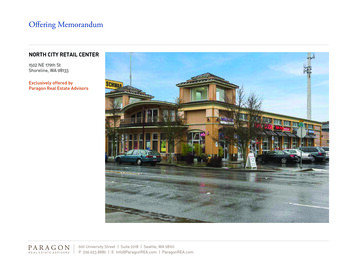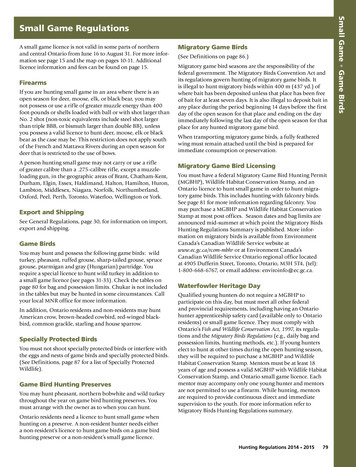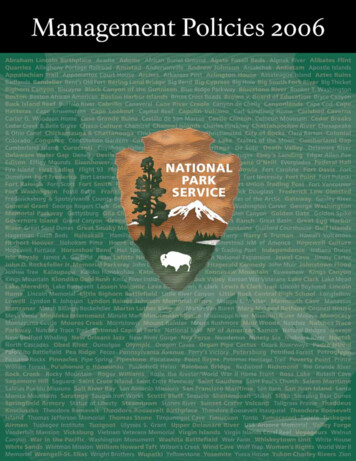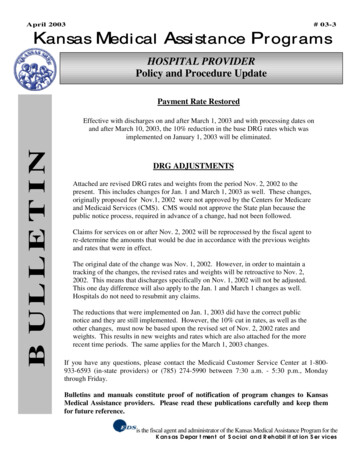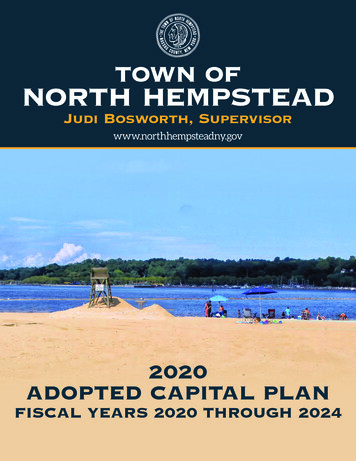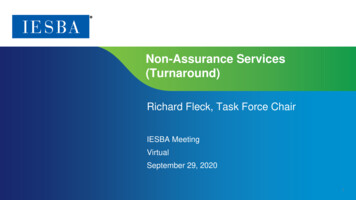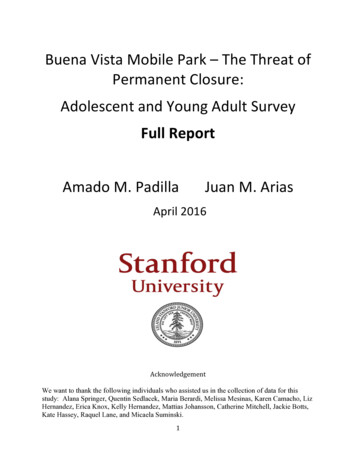
Transcription
illaJuanM.AriasApril2016AcknowledgementWe want to thank the following individuals who assisted us in the collection of data for thisstudy: Alana Springer, Quentin Sedlacek, Maria Berardi, Melissa Mesinas, Karen Camacho, LizHernandez, Erica Knox, Kelly Hernandez, Mattias Johansson, Catherine Mitchell, Jackie Botts,Kate Hassey, Raquel Lane, and Micaela Suminski.1
:AdolescentandYoungAdultSurveyFullReportAmado M. PadillaJuan M. AriasStanford UniversityGraduate School of EducationPart 1: Executive SummaryBackground InformationResidents of the Buena Vista Mobile Park in Palo Alto, California have lived with thethreat of possible park closure since the fall of 2012. The majority of the 400 residents areHispanic and long-term residents of Buena Vista Park, some residing in the park for 20 or moreyears; about one third of the residents are children under the age of 18 (see Table 1).If the park closes, many residents would lose geographic proximity to their places ofemployment since they would no longer be able to afford the cost of housing in Palo Alto ornearby Silicon Valley communities. In addition, school age children would be forced to attendlesser quality schools, and disabled and older residents would lose access to social and healthservices that are essential to their quality of life. The Buena Vista residents have formed an2
association to present a unified front against the park closure and have secured legal counsel tofight the closure or receive fair relocation compensation in the event of closure. The resident’sassociation has made two offers to purchase the park (for 14 million and 29 million,respectively) in order to keep it open, both of which have been declined by the park owner.All of the Buena Vista children and adolescents attend local elementary and secondaryschools in the Palo Alto Unified School District (PAUSD). The benefit from a PAUSD educationhas become one of the most salient issues in the debate over the closure of the park, and onereason among several for why park residents wish to remain in Palo Alto. The Buena Vistachildren are acutely aware that with closure of the Park they will most likely be forced to moveto another school district and lose friends and teachers.Goals of Current StudyIn the conducting the current Buena Vista youth survey, we purposefully began withquestions about the support that students felt they received from their families, teachers, schoolage peers, others in the Buena Vista community and adults in the larger Palo Alto community.We followed a developmental assets approach, which emphasizes that the positive assetsavailable to youth impact their resilience in response to negative events in their lives (seeBenson, 2006; 2011). Accordingly, underlying our survey was the question of whether the BuenaVista youth were resilient and if so in what ways this resilience is being demonstrated.The multi-layered goals of the current survey included the following:1. Gather information on the teens’ perception of the support they receive from theirfamily, school community, and the greater Palo Alto community regarding theclosure of the park.3
2. Inquire whether the threat of losing their home was affecting them personally,disrupting their plans for the future, or their optimism around education.3. Assess whether teens’ self-esteem and personal agency were negatively affected bythe possible loss of their home.4. Gather information on teens’ attitudes toward education, self-reported grades, andeducational aspirations for the future.5. Learn whether the teens were experiencing undue levels of stress or depression atgreater levels than other adolescents in the school community.6. Ask teens about their beliefs on the possible closure of Buena Vista and whether theirfamilies had discussed or established plans to move elsewhere.7. Learn in what ways respondents were coping during this period of uncertainty, and ifthey had participated or planned to participate in civic activities on behalf of BuenaSummary of FindingsSchool and Community Support – Table 2The first goal of the survey was to determine how much social support respondents feltthey received from their school, the community, and from their family. Importantly, 90% orhigher of male and female respondents across all age categories reported they received a highlevel of support from their school. The 90% rate of perceiving a favorable school climate amongBuena Vista adolescent residents presents a sharp contrast to results from comparableDevelopmental Assets studies conducted in PAUSD schools, in which only 47% of middleschool students and 41% of high-school students reporting a favorable school climate (SearchInstitute, 2011a; 2011b).4
Planning, Optimism, and Stability against Worry – Table 3The percentage of females (85%) and males (88%) scoring high on the composite scoresfor life planning and optimism suggest that despite the uncertainty facing Buena Visit youtharound the loss of their home, school, and community, the majority of young residents remainoptimistic about their life and their future and willing to make stable plans. This optimism atteststo the resilience that these teens are demonstrating in the face of a direct threat to their home andthe possible breakup of their family who may not be able to relocate together as a unit. Thestability against worry composite score adds evidence to the fact that these adolescents areemotionally secure despite the uncertainty of their families’ future prospects of remaining intheir mobile homes. The percent of teens responding agree or strongly agree to the questionsspecifically about being currently worried s relatively high, however, especially for the youngerrespondents. Nonetheless, it seems these youth remain optimistic and able to look beyond theirimmediate chaos of the possibility of losing their home.The differences are sharp when comparing the Buena Vista findings on planning for thefuture with the Developmental Asset findings for Palo Alto more broadly. Whereas theoverwhelming majority of Buena Vista adolescents reported that they liked to plan and that itwas helpful to set goals for the future, this was less true with Palo Alto middle school (34%) andhigh school students (36%) (Search Institute). Why this difference emerged between the BuenaVista sample and the larger Palo Alto sample is not clear, but it does attest to the resilience of theBuena Vista sample; despite the uncertainty of whether they will lose their homes, the BuenaVista youth are able to look positively toward the future and make plans.Self-Esteem and Self-Agency – Table 45
All age groups in our Buena Vista survey showed uniformly high self-esteem, both incomposite scores and in individual question responses. Self-esteem was also included on theDevelopmental Assets study and again we see striking differences between the Buena Vistasample and Palo Alto adolescents. Overall, 52% of 7th grade students in Palo Alto reportedhaving a high self-esteem and this percentage declined to 43% among the high school studentsattending the same high school as the Buena Vista students.The composite score for questions addressing feelings of self-agency, in contrast, weremuch lower for the Buena Vista youth. In our sample only 26% of females and 33% of malesagreed or strongly agreed to questions pertaining to self-agency. The youngest age group of 1213 year olds (n 21) was the least likely to agree to the self-agency questions with just 5% inagreement. This finding is not necessarily surprising because this age group (12-13 years), whilehaving entered adolescence, is still dependent on their adult caretakers. In addition, sincerespondents come primarily from immigrant families, many of them likely experience strongfamily values around respect for elders and dependency on their parents for decision making.Adolescents were very supportive of standing up for equality (97% females and 88%males), a pattern that is seen across all age categories. A similar question in the DevelopmentAssets survey revealed that a lesser percent of general middle school (61%) and high schoolstudents (57%) felt as strongly about equality as the Buena Vista adolescents. It may be thatadolescents who see disparities on a daily basis—much as the Buena Vista residents do—aremore predisposed to stand up and take a position against inequality.Academic Measures – Table 5The educational aspirations of Buena Vista youth indicated that most hoped to continuetheir education beyond high school. Specifically, more than 80% of males and females reported6
that they hoped to attend at least 2 years of colleges following high school graduation, with 58%of girls and 75% of boys aspiring to attend 4 or more years of college.Since attending college is tied directly to academic performance in high school, studentswere asked to self-report their grades. Overall, 45% of the females answered that their gradeswere “about half As and Bs or better”, whereas fewer males (30%) self-reported their grades inthis range. Also, fewer students in the high school age ranges reported having “half As and Bs orbetter”, with 10% of 14-15 year olds and 12% of 16-17 year olds reporting as such. These ageranges correspond to students in the 10 through 12th grades, where the academic pressure forgrades is known to be severe in the PAUSD.Few respondents reported that they did 3 or more hours of homework each night (males10% and females 17%). There was a good amount of variability on this question, however, with40% of the 14-15 years answering affirmatively to the question of 3 hours or more of homeworkwhereas none of the 16-17 and 18-19 year olds reported spending 3 hours or more doinghomework. An important point to make about time spent on homework is that it is likely thatfew of our respondents had the luxury of space in their mobile homes to be able to study withany amount of privacy or time free of distractions from other members of the household. Inthese respects the Buena Vista teens may be at a major academic disadvantage compared to mostPAUSD secondary level students.Nearly all of the respondents (90-100%) indicated that they were trying their “best inschool”. In similar fashion almost all of the respondents (93-95%) stated that they cared abouttheir school. These findings are positive because they demonstrate that while the Buena Vistastudents are a marginalized population in Palo Alto because of their low-income status, the7
adolescents nevertheless have a strong sense of belonging to their school community, which isknown to correlate highly with future academic achievement.Depression, Anxiety, and Stress – Table 6None of the younger Buena Vista students (12-13, 14-15 year olds) reported feeling sador depressed in the last month. For the older Buena Vista respondents, overall 12% of the girlsand 8% of the boys answered that they had experienced sadness or depression most or all of thetime in the past month. This finding is favorable in comparison to response rates from the 2010Developmental Assets survey among high school students, where 16% of the girls reportedfeeling sad or depressed most or all of the time in the last month. This favorability changedsomewhat for 16-17 year olds, with 38% (n 8) reporting that they felt sad/depressed most or allof the time. For Gunn High School students of similar age, 30% reported being sad or depressedmost or all the time.Opinions on Status of Buena Vista Mobile Park – Table 7Since most of the survey respondents are attending school, the future of Buena Vistaweighs heavily in the minds of nearly half of the teens overall and this worry increases to 71%for the 16-17 years who have expressed concern about not being able to graduate from GunnHigh School if the Park closes. These concerns are likely related to the arguments many adults inBuena Vista and their Palo Alto supporters have been making about the scarcity of affordablehousing in Silicon Valley. If forced to move because of the closure of the Park most familiesface the uncertainty of having nowhere to move to in this or surrounding areas.8
Actions Taken By Teens in Response to Potential Closure – Table 8In order to assess the actions taken by Buena Vista adolescents in response to the possibleclosure of the Park, we asked a series of questions about how the teens have engaged with thecommunity about the Park closure. About half of both males and females reported that they hadparticipated in rallies and meetings to express their support against the closure of the Park. Inaddition, slightly more (57%) of the adolescents indicated that they had attended Palo Alto CityCouncil meetings when Buena Vista was being discussed. We also asked whether theadolescents had participated with their parents in the actual search of housing should their familyhave to leave Buena Vista. To this question 55% of the respondents indicated that they hadalready searched or helped their parents search for housing.Possible Future Actions – Table 9A final block of questions in the teen survey asked what activities the respondents werelikely to participate in regarding the status of the Buena Vista community going forward. Inresponse to whether they would be interested in participating in discussion groups with same-agepeers, the youngest age group (12-13 year olds) expressed the most willingness (48%) to meetwith age peers to discuss Buena Vista. To the question of whether they were likely to attendfuture city council meetings or public rallies to support Buena Vista, 55% of the females statedthat they were “likely or very likely” to attend such events; males were slightly less likely (48%)to attend such events. Additionally, 71% of the 12-13 year olds indicated that they were likely toattend such events. In the past these younger teens have usually been seen accompanying theirparents to city council meetings and public rallies. Lastly, the teens were asked how likely itwould be for them to help their family search for available housing options if necessary. 76% of9
the females said that it was “likely or very likely” that they would help, contrasted with 58% ofthe males. Not surprisingly, the two older groups of respondents (70% - 88%) indicated a greaterlikelihood of helping in the search for the housing available if forced to leave Buena Vista.ConclusionsIn this study of 58 adolescents and young adults between the ages of 12 and 24 years ofage, we found that overall the respondents believed strongly that they were supported by teachersand classmates and that their school encouraged them to do their best. The adolescents alsoexpressed a strong bond with their schools. This finding is important because one of thearguments posed by the Buena Vista parents for wanting to remain in Palo Alto was the qualityof the schools that their children attended and their strong connection to those schools.Another important finding was the strong support adolescents received from their parents,the Buena Vista community generally, and the greater Palo Alto adult community. This findingattests to the positive assets reflected in the adolescents’ lives from family, school, Buena Vistaand Palo Alto more broadly. These assets are likely linked to the high self-esteem and personalagency reported by both males and females and across all age groups. Coupled with this patternis the fact that Buena Vista adolescents and young adults were nearly uniformly in agreementabout the value of setting goals and planning for the future and “finding positives, even in theworst of situations”. Keeping with the idea of future planning and remaining optimistic abouttheir future, the adolescents and young adults indicated their desire to attend college and receive2 or more years of higher education.On the question of mental health only a small number of adolescents reported feeling sador depressed during the past month and the overwhelming majority felt that they could handle10
their personal problems. These findings are important because they show that despite theenormous pressure that the Buena Vista families have been under for more than three years, theadolescents and young adults have remained resilient to threat of the closure of the Park and theloss of their home, school, friends, and communities. The youth of Buena Vista have assistedtheir parents in the search for adequate housing if the time comes that they need to relocate. Inaddition, they have participated in positive civic engagement to protest the closure of the Parkand attended and spoken at public hearings. The Buena Vista youth express pride in their familyand community and have remained optimistic about their future.Part 2: Buena Vista Adolescent Survey – Full ReportThe loss of one’s home can be a major life event that has the potential of creatingenormous stress in a person’s life. Residents of the Buena Vista Mobile Park in Palo Alto,California have lived with the possible closure of the Park since the fall of 2012 when the ownerinformed residents that he would begin the formal process mandated by state and localregulations to close the Park. Since then the 400 low-income residents, including approximately130 children have received widespread publicity locally, nationally and internationally in themedia as they fight to remain in their mobile homes in upscale Palo Alto (Dreman, 2012;Passariello, 2015; Neate, 2015). The majority of the residents are Hispanic and long-termresidents of Buena Vista, some residing in the park for 20 or more years. Since the ownerannounced his intention to close the park, residents in their struggle in remain in their homeshave received support from many individuals and groups in Palo Alto and surroundingcommunities.11
The Buena Vista residents have engaged in various tactics to remain in their homesincluding the formation of an association to present a unified front against the park closure. Inaddition, residents secured legal counsel to fight the closure while also working to ensure that ifthe park closes they receive fair relocation compensation and fair market value for their mobilehomes most of which are no longer mobile even if there was a location to move to. In theensuring three years, the leadership of the resident’s association and many Buena Vista residentshas appeared at numerous community events to speak against the closure of the park. Theresidents and their supporters have offered testimony in public hearings that if the park closesmany residents would lose geographic proximity to their places of employment since they wouldno longer be able to afford the cost of housing in Palo Alto or even in nearby Silicon Valleycommunities. In addition, school age children would be forced to attend lesser quality schools,and disabled and older residents would lose access to social and health services that are essentialto their quality of life.In addition, the resident’s association has on two separate occasions offered to purchasethe park from the owner. The first offer of purchase was for 14 million and was turned down bythe owner. In late spring 2015, the City Council of Palo Alto and the Santa Clara County Boardof Supervisor each agree to put 14.5 million earmarked for low income housing into a fund forpurchase of the mobile park by a non-profit organization that operates mobile parks in SouthernCalifornia. Subsequently, a second offer of 29 million was offered to the owner for purchase ofthe park, but was again rejected by the owner (Sheyner, 2015). Further, over the course of threeyears all of the public events regarding the closure of the park have been well attended by the fullspectrum of residents of Buena Vista including children and adolescents.12
In 2014 Barr & Padilla conducted a census of all children below the age of 18 living inthe par
The 90% rate of perceiving a favorable school climate among Buena Vista adolescent residents presents a sharp contrast to results from comparable Developmental Assets studies conducted in PAUSD schools, in which only 47% of middle-school students and 41% of high-school students reporting a favorable




